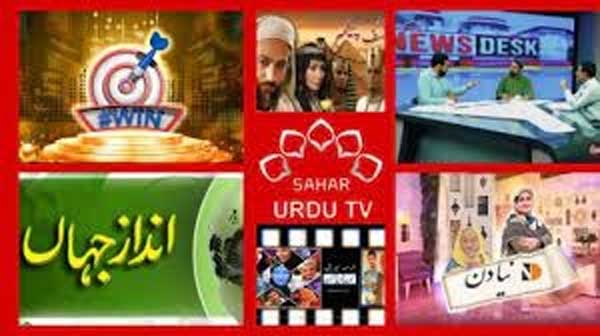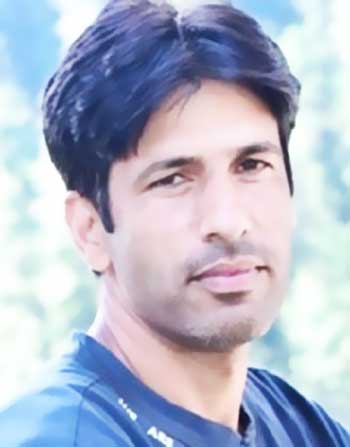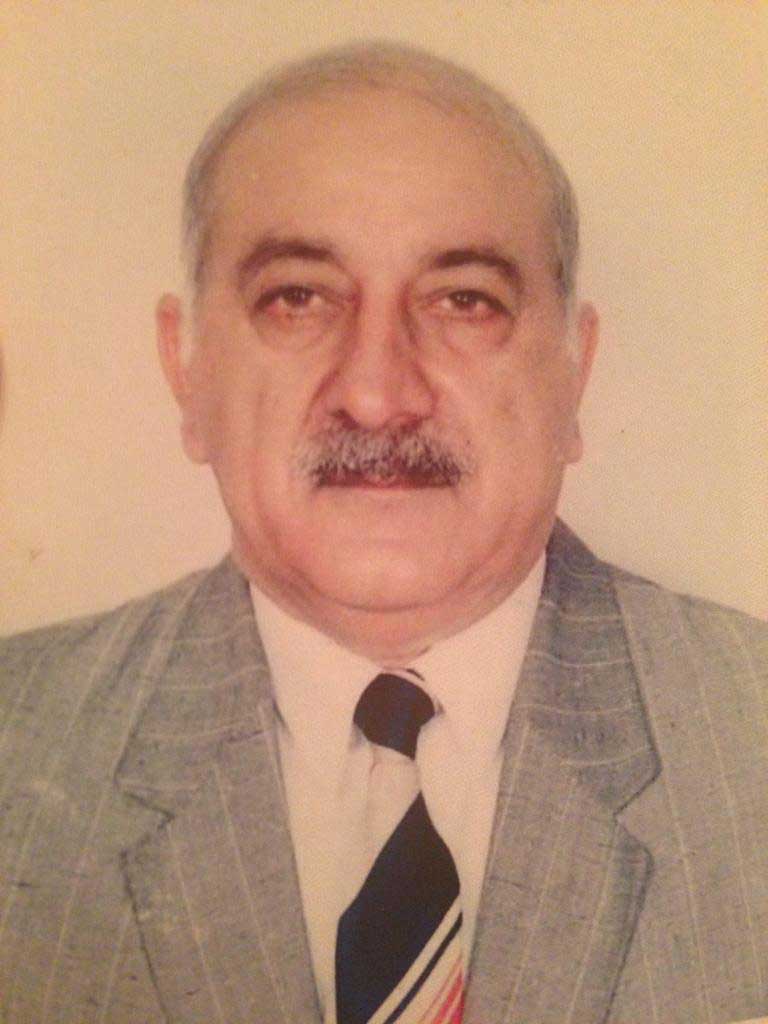
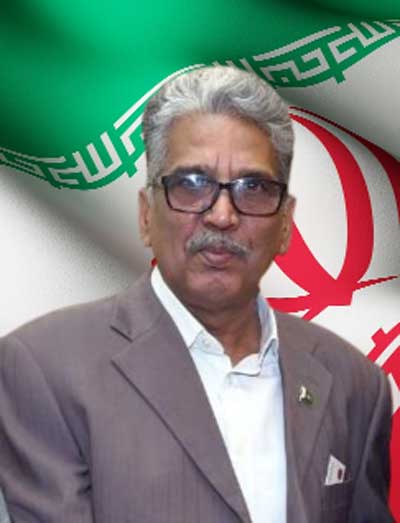
After taking our late sumptuous and memorable but late lunch, our next destination with Ali Fatimi was the state Television of Iran the Sahar TV.
Sahar TV, as part of the Sahar Universal Network and the broader Islamic Republic of Iran Broadcasting family, is more than just a television channel. It is a symbol of Iran’s commitment to sharing its culture, values, and ideas with the world. Through its diverse and engaging programming, Sahar TV continues to serve as a bridge of understanding between different cultures, fostering connections and promoting dialogue on a global scale. In an era where communication is vital for international relations, Sahar TV plays a significant role in promoting cross-cultural understanding and cooperation.
Sahar Urdu TV broadcasts films, dramas, features, and documentary programs on religious, cultural, historical, social, political, and tourism-related topics. Additionally, they present programs covering important global news and current events. In their news and current affairs programs, they prioritize issues related to the Islamic world, Iran, and South Asia, providing comments and analyses while maintaining full impartiality and presenting objective facts.
Sahar TV stands as a beacon of cultural exchange and information dissemination for the Islamic Republic of Iran. This Iranian television channel is an integral part of the Sahar Universal Network (SUN), which, under the aegis of the Islamic Republic of Iran Broadcasting (IRIB), is responsible for sharing programs globally in Azeri, Balkan, Kurdish, and Urdu languages. This article delves into the history and significance of Sahar TV, highlighting its role in connecting diverse regions of the world through its unique programming.
About Sahar Urdu TV
Sahar International Network’s Urdu broadcasts began on May 1, 2001. Initially, the duration of the broadcasts was thirty minutes, which was later extended to ninety minutes in the mid-2002. Starting from January 1, 2010, the broadcast duration was increased again to three hours, and in the same year, in November 2010, it was extended to four hours. On May 11, 2011, in celebration of Sahar Urdu TV’s tenth anniversary, the broadcast time was further increased by four hours.
Since November 2014, the broadcasts on Sahar Urdu TV have been extended to fifteen hours from the initial eight hours. On July 26, 2015, Sahar Urdu TV extended its broadcasts by an additional three hours, making the broadcast duration seventeen hours. Finally, with the help of Allah and due to the sincere messages from viewers, starting from September 30, 2015, Sahar Urdu TV’s broadcasts have been extended to twenty-four hours.
Sahar TV of Iran: A Window to Culture, Politics, and Spirituality
Sahar TV of Iran stands as a beacon of communication, offering a rich tapestry of programming that reflects the diverse facets of the nation, from its cultural heritage to its political landscape. As a renowned television channel, Sahar TV has etched its presence in the hearts and minds of viewers, both within Iran and across the globe. This esteemed media outlet serves as a multifaceted platform, encompassing news, current affairs, entertainment, and religious programming.
A Global Reach
Sahar TV’s reach extends across vast geographical regions, making it a truly international broadcaster. It provides content not only to its primary target audience in Europe but also to Central Asia, the Caucasus, Northern Africa, Oceania, the Indian subcontinent, and Eastern Asia. This extensive footprint underscores its commitment to sharing Iran’s culture, values, and perspectives with the world.
A History of Evolution
The journey of Sahar TV began on 16 December 1997, when it took its first steps into the world of broadcasting by offering one hour of English programming daily. Over the years, it has expanded its airtime to four hours a day, reflecting its growing importance in facilitating cross-cultural understanding.
A Diverse Range of Content
While Sahar TV primarily aims to propagate Islamic education and values, its programming transcends the boundaries of politics and news. The channel offers a diverse array of content, including scientific and social documentaries, clips, and game shows. This eclectic mix caters to a wide audience, ensuring that viewers with various interests find something appealing.
Islamic Education
Sahar TV plays a pivotal role in disseminating Islamic teachings and values. It serves as a platform for scholars and experts to discuss religious topics, providing viewers with insights into Islam’s rich heritage.
News and Politics
In addition to its educational content, Sahar TV keeps viewers informed about global events, politics, and developments. By presenting news and analysis from an Iranian perspective, it contributes to a more well-rounded understanding of international affairs.
Scientific and Social Documentaries
The channel showcases documentaries that explore various aspects of science, history, culture, and society. These programs encourage viewers to engage with knowledge and broaden their horizons.
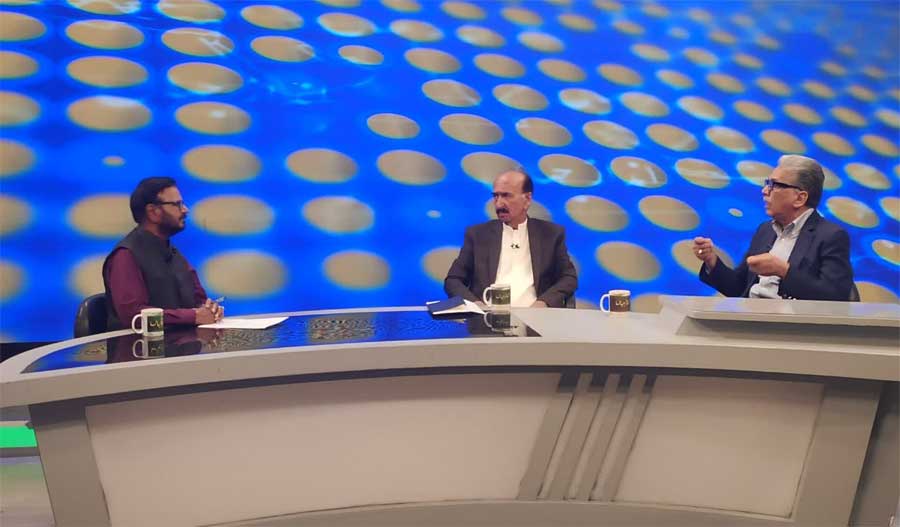
Clips and Entertainment
Sahar TV understands the importance of entertainment in television. It offers clips and entertainment shows that provide viewers with light-hearted content and moments of relaxation.
Game Shows
Game shows are a unique feature of Sahar TV, adding an element of fun and interactivity to its programming lineup. These shows engage the audience and foster a sense of community.
Fostering Cultural Exchange
Sahar TV plays a crucial role in bridging cultural gaps and fostering understanding between Iran and the diverse regions it reaches. By offering content in various languages, including Azeri, Balkan, Kurdish, and Urdu, the channel ensures that it can effectively communicate with its target audiences. This approach not only enhances cultural exchange but also promotes dialogue and mutual respect.
Objectives of Sahar TV
Promoting Islam and Islamic teachings and advocating for the betterment of human destinies.
Raising a voice for the oppressed, regardless of race, religion, or nationality.
Promoting the message of Islamic unity and bringing different factions closer to each other.
Unmasking conspiracies by imperialist powers against the Islamic world.
Eliminating propaganda by imperialist powers against the Islamic Republic of Iran.
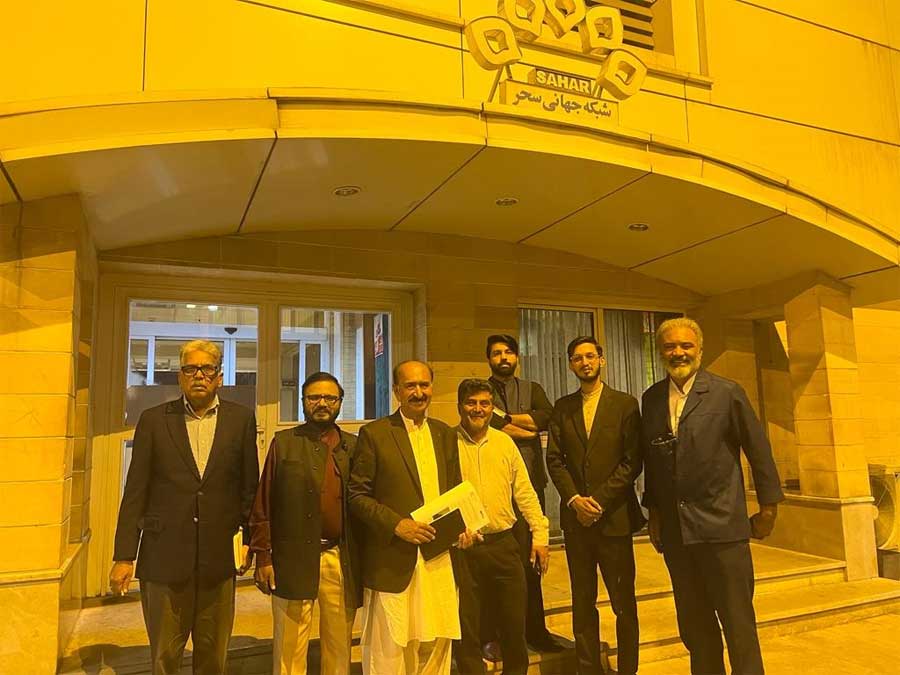
Memorable experience of the visit of Sahar TV
Upon our arrival at Sahar TV, we embarked on a journey that would unveil the depth and significance of this iconic channel. After navigating through the necessary security procedures, we were warmly welcomed by Syed Hassamuddin Mohajri, the dedicated Producer of Political Programmes for the Urdu Service at Sahar TV. His enthusiasm and passion for the channel were palpable as he ushered us into the world of Sahar TV.
Intriguingly, Sahar TV’s reach extends far beyond its borders, and its popularity is a testament to the meticulous organization and content it offers. Mohajri gave us an insight into the inner workings of Sahar TV, highlighting its role in shaping public discourse in the region.
Our journey continued as we were introduced to the Urdu department of Sahar TV. Rashid Naqvi, an accomplished Producer and Anchor, Syed Gulshan Abbas Naqvi, a proficient Farsi to Urdu translator, and Qamar Abbas, another skilled translator, briefed us about the Urdu services offered by Sahar TV. Their dedication to bridging linguistic gaps and ensuring that the message of Sahar TV resonates with Urdu-speaking audiences was evident.
As the discussion unfolded, we learned about the myriad Urdu programs Sahar TV offers, delving into the details of these enriching and informative shows that cater to a diverse audience. These programs serve as a vital channel for connecting viewers with the culture, politics, and spirituality of Iran, transcending linguistic boundaries and providing valuable insights into Iranian society.
One particularly captivating moment of our visit was being invited to participate in the live show “Andaz Jahan,” hosted by the talented Muhammad Mehdi Sharfat. This popular program seamlessly blends entertainment and education, offering viewers a unique and engaging experience. We were privileged to witness Sharfat’s adept hosting skills as he conducted the show with finesse, further underscoring Sahar TV’s commitment to quality programming.
Sahar TV of Iran is more than just a television channel; it is a cultural ambassador, a political commentator, and a spiritual guide. It plays a vital role in connecting viewers not only within Iran but also around the world. With its diverse range of programming, Sahar TV continues to be a significant platform for promoting the values and teachings of Islam, while also shedding light on the contemporary issues that shape the narrative of Iran. Our visit to Sahar TV was a journey of discovery, a testament to the power of media in fostering understanding and connectivity across borders.
Here’s an English translation of a segment from the Urdu Travelogue “Iran aur Inqilab” written by Mr Nazir Leghari about our recent visit:
Today, after visiting Jamaran and Saadabad Palace Complex, everyone was tired. I was also among them. Ali Fatemi had estimated this, so he took us to a restaurant near our hotel. The restaurant was a place where it rained colors and lights at night and created an atmosphere of pouring rain during the day. It felt like we were the only ones who had come to such a large restaurant, and the rest of the people had already left after having their lunch. But we had come quite late in the afternoon, so we had to spend some time reminiscing about the day’s activities before the food arrived.
When the entire meal was served, I felt that all the previous deficiencies had been compensated for today. After enjoying the meal and listening to wedding songs, we returned to our hotel. Upon reaching the hotel, Ali Fatimi announced that we would go to the Iran TV station after an hour. We spent an hour sitting in the hotel lobby. Our other companions gradually emerged from their respective rooms at the appointed time. We all got into the car, and the car headed towards the Iran TV headquarters. When we reached the main gate of this headquarters, our car was stopped.
We started comparing this headquarters with the Islamabad TV headquarters. Its area is much larger than that of the PTV headquarters. Here, it is referred to as “Islamic Republic of Iran Broadcasting” in Persian. Before the revolution, its name was “National Iranian Radio and Television.” After the revolution, the government has controlled this institution, and even before the revolution, the government used to control it. This institution is a member of the Asia-Pacific Broadcasting Union. It is considered the largest media organization in the region. It is said that the head of this organization is directly appointed by Iran’s Supreme Leader, Ayatollah Khamenei. This organization has an annual revenue of 95 million dollars. In Iran, radio was established in 1929, while television was established here in 1958. The number of employees of this institution is said to be 13,000, and it has branches in 20 countries around the world.
Here, there are 12 local TV channels, and four international news TV channels. At the provincial level, there are 30 TV channels, including channels in languages other than Persian, such as Azerbaijani and Kurdish, as well as channels in different dialects of Persian. In Iran, there are 12 radio stations for local listeners, while there are 30 radio stations for international and non-Iranian listeners.
We had to wait at the main gate of the headquarters for quite some time. Now, Mirza Ghalib’s verse was echoing in our minds:
“Bandagi mein bhi woh azaad-o-khud-bain hain ke hum,
Ulta phir aaye dar-e-Ka’ba agar waa na hua.”
But isn’t our fundamental training as journalists supposed to be that we should not display any impatience for news, information, acquiring knowledge, or for the sake of a newspaper or channel, but rather, we should be selfless and not entirely self-centered for these purposes. Therefore, we followed in Ghalib’s footsteps and patiently waited with delight in the car.
After a considerable wait, we were asked to proceed towards the reception area for security clearance. Obviously, we didn’t have any questionable items for security. Could it be that they wanted to make a phone call to us? But why? We weren’t some invited guests. However, in our own country, there are several places where guests are respectfully invited and then taken aside for a phone call. Well, we arrived at the reception area with our fingers crossed. Shortly afterward, we found out that Ali Zain Naqvi’s name was not on our delegation list. They asked us to sit down and go inside. My heart sank. Typically, in my own country, I would return in such a situation. We weren’t entirely self-centered, but why would someone stop one of our fellow travelers and make us raise our heads and head towards that place. Then we convinced ourselves that everywhere in the world, security personnel work according to rules. Perhaps, they mistakenly thought that Ali Zain Naqvi was separate from our delegation due to arriving a week earlier. We exited the security building and arrived on a wide road in front of the Iranian TV headquarters.
Here, a kind person introduced himself in Urdu and told us his name was Syed Hassamuddin. We immediately recorded our protest at Ali Zain Naqvi’s being stopped. In the meantime, our car had already reached the same place. Syed Hassamuddin said that he would take Ali Zain Naqvi to our car. It turned out that the Iranian TV building was much larger than our PTV building in Islamabad. Initially, it was a radio building, and then when TV came along, Iranian TV was also established in the same building. This way, all media institutions were consolidated. We couldn’t ask whether the Urdu broadcasts that we used to hear on Radio Iran Zahedan 50 years ago also originated from this place or whether there was a separate station in Zahedan.
We had to cover quite a distance from the TV headquarters gate to the central building to reach our car. It’s also possible that due to the hassle of stopping Ali Zain, we felt that this distance was greater. Syed Hassamuddin took us to another house through the left. We requested him to introduce himself fully. They are the producers of the Urdu section of Iranian TV. Manzar Naqvi sahib asked them which city in Pakistan they were from. They said that their name is Syed Hassamuddin Muhajir, and in your opinion, which city will I be from in Karachi? Manzar sahib asked them where in Karachi his house is. Syed Hassamuddin Muhajir said, “Well, now I can say with certainty that you are from Liaquatabad.” Naqvi sahib asked him, “Is it Liaquatabad where the school is English medium?” Muhajir replied, “Yes, it’s an English medium school, but even in my class, there were students who spoke Urdu.” In this room, there are several chairs and tables. This is the Urdu section, and here sit Urdu copy editors, translators, and other staff members.
Syed Hassamuddin Muhajir introduced us to his other friends in the office. On one seat, Syed Gulshan Abbas Naqvi was sitting; he is the Urdu editor. He is from Sialkot. Another seat belonged to Qamar Abbas, who translates news or other journalistic material from Persian and English into Urdu. We asked them which city they were from, and they told us that they are from India. When we inquired about the name of their city, they said that now a neighborhood of their city, which shares its name with our Islamabad, has gained significant fame. We looked at them with questioning eyes, and they said that their connection is with Faizabad. We thought to ourselves that Faizabad, which used to be known for the protests and sit-ins in our country, has now become famous in Islamabad. And there, it seems that Faizabad has overshadowed Ayodhya’s recognition, which used to be known as the state of Uttar Pradesh in India. Faizabad is located on the banks of the Sarayu River. Faizabad is located 130 kilometers to the east of Lucknow. Faizabad was the first capital of the rulers of the state of Oudh.
I thought to myself whether I should ask Qamar Abbas about his employment at Iran TV based on some connection with the Nawabs of Oudh, but then I realized that this could be a serious matter or a joke, and Faizabad’s Qamar Abbas and Islamabad’s General Faiz and Syed Khadim Hussain Rizvi may also have been asked about their connection. I could have been stumped by such a question. We were still sitting there when Muhammad Mehdi Sharafat, the anchor of Sehar TV, also arrived. About five or six years ago, Iran TV used to include us in their programs from Karachi. Now Sharafat Sahib had the opportunity to say, “Sharafat, stand up,” and present his analysis in Sehar TV’s live broadcast. Like Manzar Naqvi Sahib, Mohammad Sharafat was also participating in Sehar TV programs from Karachi.
We expressed our desire to our young colleagues that they should also be included with us, but they said that there was only room for two guests in the studio. So, I suggested that Owais Rabbani Sahib should be included in my place, but they said that they had already promoted our names. Now we had to sit in the studio, and there were twenty minutes left. In the meantime, suddenly, Rashed Sahib came in. He seemed familiar to me, and without introducing himself, he said that we had met in a hotel in Karbala five years ago, where, apart from him, we were also staying in the residence of Dr. Qamar Abbas of Dera Ismail Khan when it became known that we were coming to Iran, so he had sent Dr. Qamar Abbas to our hotel as our translator. Meeting Rashed Sahib was a pleasant surprise, and we expressed our happiness.
We had asked someone here about an incident that occurred three years ago, which had garnered a lot of attention in the Western media. It happened in such a way that suddenly on March 31, 2020, breaking news started circulating in the Western media that there had been a major explosion near the headquarters of Iranian radio and television early in the morning. Some Western channels were also reporting news of explosions in the area.
Keeping preconceived notions about Western media or any media is not appropriate, but unfortunately, after the fall of the Soviet Union, the coverage by Western media of Iran, its presentation style, and the content of the news have been quite unique. Certainly, if it’s a matter related to Palestine and Israel, the Palestinian victim will be portrayed as oppressed, and the Israeli military as helpless victims, just a mere statement. On that day, we also tried to gather information from various sources about the news of the explosions. The explosions and the fire happened at different locations, but Western media had linked and related these events, drawing their own conclusions.
However, the general public in Iran, especially the residents of Tehran, were mature and understood the situation to a great extent. They were not influenced by such agenda-driven news. Mr. Muhajiri joined us in the studio. I was seated in the middle. On one side, the program anchor, Mohammad Mehdi Sharafat, welcomed us, and on the other side was Mr. Manzar Naqvi.
The program aimed to compare and analyze the media of the developed world, Islamic countries, and the Western world. We began our conversation with this premise. I expressed my gratitude to the hosts and pointed out that the image of Iran presented by the media of developed Western countries is quite different from the reality. I can confidently say that Iranian women have opportunities, authority, decision-making power, and choices in the media field to a degree that many developed countries, including technologically advanced nations, lack. In fields such as science and technology, engineering, industry and crafts, and business, Iranian women have made significant strides. Similarly, in the field of cinema, Iranian women have achieved great success. Generally, women in the media industry have more opportunities compared to political reporting, but in Iran’s largest news agency, women have authority in political reporting, presidential reporting, parliamentary reporting, judicial reporting, sports reporting, and displaying news on the desk.
I have not seen such opportunities for women in journalism in South Asia, the Middle East, and to a large extent, Europe. On the contrary, Western media portrays Iranian women as unable to leave their homes, unable to enter the market, and as prisoners in their own homes. However, coming here, we have seen that men and women are partners in the race of life, equally.
Mr. Manzar Naqvi also spoke about the approach of Western media in Iran. He also openly discussed opportunities for women in Iran. He mentioned that he had seen women driving buses on the streets of Tehran the previous day. He said he had seen women working confidently in various fields such as urban planning, the hotel industry, marketing, and more. At this point, we were asked about the possibility of cooperation between developed countries and Islamic countries. I suggested that in the Islamic world, there are conferences, seminars, and meetings on various topics related to cooperation. To foster cooperation between developed and Islamic countries, an Islamic Media Conference or a Third World Media Seminar should be organized. Until we are aware of each other’s issues and opportunities, we cannot progress together.



